Exploring Saudi Cuisine in Dubai: A Culinary Journey
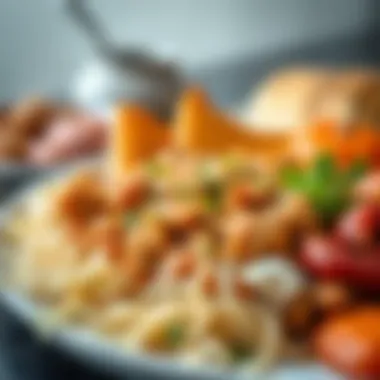
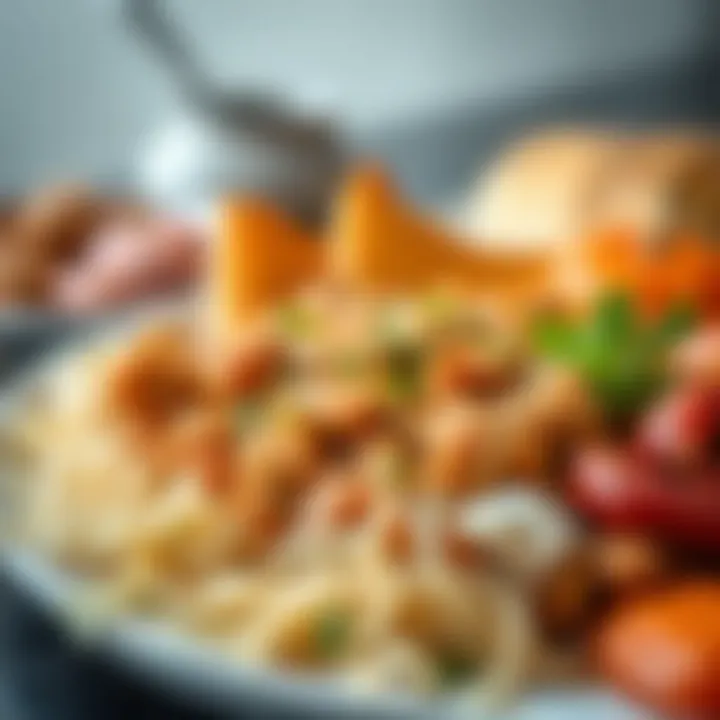
Intro
In the bustling city of Dubai, where skyscrapers kiss the clouds and cultural melanges unfold at every corner, the culinary tapestry is richly woven with threads from around the globe. Among these vibrant flavors lies the inviting essence of Saudi cuisine, a gastronomic endeavor that reflects not only its traditions but also the broader cultural journey of the region. With a significant expatriate population, mainly from Saudi Arabia, Dubai provides an apt backdrop for exploring how these culinary delights have been embraced and adapted within this metropolis.
The importance of food transcends mere sustenance in Saudi culture; it symbolizes hospitality, family, and togetherness, imbuing every meal with layers of meaning. This exploration digs deep into Saudi dining experiences within the tapestries of Dubai's diverse food scene, focusing on established restaurants that serve authentic flavors from the heart of Saudi Arabia. From the aromatic spices to delightful dishes, each morsel tells a story rooted in time-honored traditions and modern interpretations.
Expatriates play a pivotal role in this culinary narrative, bridging the gap between their native kitchens and the eclectic gastronomical landscape of Dubai. Their influence brings an evolving flavor palate, where traditional dishes meet innovative presentations, captivating both curious locals and tourists alike.
As we embark on this journey, we will highlight key dining establishments that accentuate Saudi flavors in Dubai, offering insights into unique dishes and dining atmospheres. This narrative aims not only to celebrate Saudi cuisine but also to underline its cultural significance, particularly in fostering culinary tourism in a city known for its rich gastronomic variety.
By delving into these flavorful escapades, readers can expect to uncover hidden gems and dining experiences that may pique their culinary interests, while also illuminating the broader implications for the integration of Saudi heritage in Dubai's lifestyle.
"Food is not just what we eat; it is the structure upon which we build our conversations and represent our cultures. "
Preface to Saudi Cuisine
Saudi cuisine is a vibrant tapestry woven from centuries of traditions, cultural significance, and regional diversity. In the bustling city of Dubai, the rich flavors of Saudi food act not only as a culinary delight but also as a bridge between two distinct yet interconnected cultures. Exploring this cuisine allows diners to journey through its unyielding historical roots, cultural symbols, and the essence of Saudi hospitality.
Whether one is indulging in a seasoned plate of kabsa or sipping on aromatic saffron tea, every dish tells a story. These narratives are vital for understanding the essence of Arabian culture and heritage. In this article, we will embark on a deeper exploration of what Saudi cuisine means, zeroing in on its historical context and its culinary symbols. This exploration is particularly relevant for investors, homebuyers, and expats looking to connect with the local culture and its community through food, transforming simple dining into a rich cultural experience.
Historical Context of Saudi Food
Saudi cuisine is as ancient as the sands of the Arabian Peninsula itself. It has been influenced by various civilizations over millennia, including the Ottomans, Persians, and even the Egyptians. The geographical importance of Saudi Arabia as a trade route also plays a key role; spices, herbs, and cooking techniques flowed through this region, enriching its culinary practices.
Additionally, the Bedouin tribes have shaped the food culture by emphasizing a nomadic lifestyle, relying heavily on ingredients available in their environment. Meat, particularly lamb and chicken, often takes center stage in main dishes, while grains like rice and wheat are staples in everyday diets. Understanding this context is essential for grasping how meals are not just food, but reflections of the land and its history.
"Food is a story, and every Saudi dish speaks of its past with pride and depth."
Culinary Symbols of Saudi Culture
Food in Saudi Arabia serves as a language of social connection. It embodies hospitality, generosity, and community bonding. The act of sharing meals often transcends mere sustenance; it fosters relationships among families and friends.
Some culinary symbols include:
- Kabsa: Often considered the national dish, kabsa encapsulates the essence of communal dining. Served on large platters, it's a dish that brings people together.
- Dates: A staple in Saudi households, dates symbolize hospitality. At gatherings and during Ramadan, offering dates is a customary gesture of welcome.
- Arabic Coffee: Known as qahwa, it holds a significant place in Saudi culture. The ritual of serving coffee, often with dates, is a mark of respect and friendship.
- Fattah: A layered dish combining bread, rice, and meat, it showcases the resourcefulness of Saudi cooking—turning leftovers into something hearty and delicious.
In understanding these symbols, one begins to appreciate the depth of Saudi culture embedded within its cuisine. They play a vital role, not only in preserving traditions but also in nurturing the sense of identity among the Saudi populace.
Saudi Restaurants in Dubai: An Overview
When one thinks of the vibrant culinary scene in Dubai, the diverse influences that converge in this metropolis cannot be understated. Among these, the presence and growth of Saudi restaurants hold a significant place. The emergence of these establishments reflects not just a culinary interest but a deeper cultural resonance, making them a vital aspect of the larger tapestry of Dubai’s food offerings. Saudi cuisine, rich in heritage, brings flavors that resonate well with both locals and expatriates, enhancing the gastronomical landscape of the city.
The growth of Saudi dining establishments has been quite notable in recent years, influenced by various factors including the increasing population of Saudi nationals and expatriates in Dubai, as well as the rising interest in authentic Middle Eastern flavors among tourists and locals alike. These restaurants have become popular not just for the food they serve, but also as social spaces that foster community ties among patrons who share common cultural backgrounds.
Growth of Saudi Dining Establishments
The evolution of Saudi dining in Dubai mirrors broader trends observed in the city. More than just satisfying hunger, these restaurants serve as a platform for sharing traditions and fostering connections. Partners in culinary ventures have opened places that range from casual eateries to upscale dining experiences, representing various facets of Saudi Arabian dining culture.
- Diversity of Offerings: Today, diners can enjoy a spectrum of options whether they're seeking a quick meal or a refined dining experience. From Kabsa to Mandi, the variety showcases different cooking techniques and flavors that are integral to Saudi culture.
- Culinary Innovation: Some Saudi restaurants in Dubai incorporate modern techniques or fusion elements, crating an interesting mix while still honoring traditional recipes. This openness encourages culinary exploration, engaging a wider audience drawn to the unique tastes of Saudi cuisine.
This growth marks a growing recognition and appreciation of Saudi cuisine in the culinary hub of the UAE. The interplay of traditional recipes with contemporary dining styles has attracted a diverse clientele, establishing these establishments as significant contributors to the food culture in Dubai.
Comparison with Other Culinary Offerings
In a global city like Dubai, the competition among various culinary offerings is fierce. Saudi restaurants stand out, not only due to their unique flavors but also by the warmth of their hospitality, setting them apart from other dining options.
- Cultural Authenticity: While many restaurants offer a mix of Middle Eastern flavors, Saudi eateries focus on authenticity, ensuring that the dishes reflect traditional cooking methods and ingredients. For example, compared to Lebanese or Emirati cuisine, Saudi dishes often emphasize rice and meat as staples mountain flavors.
- Dining Experience: The ambiance in Saudi restaurants often mirrors that of traditional Saudi homes, providing diners with an inviting atmosphere that enhances their overall experience. Many of these establishments decorate with cultural artifacts and authentic decor, further immersing patrons in the Saudi culinary culture.
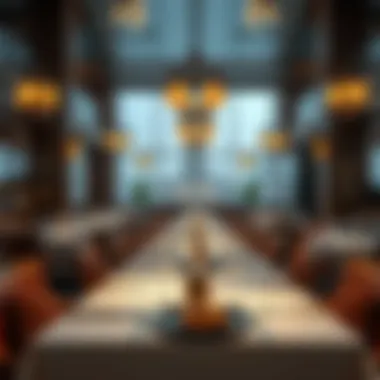
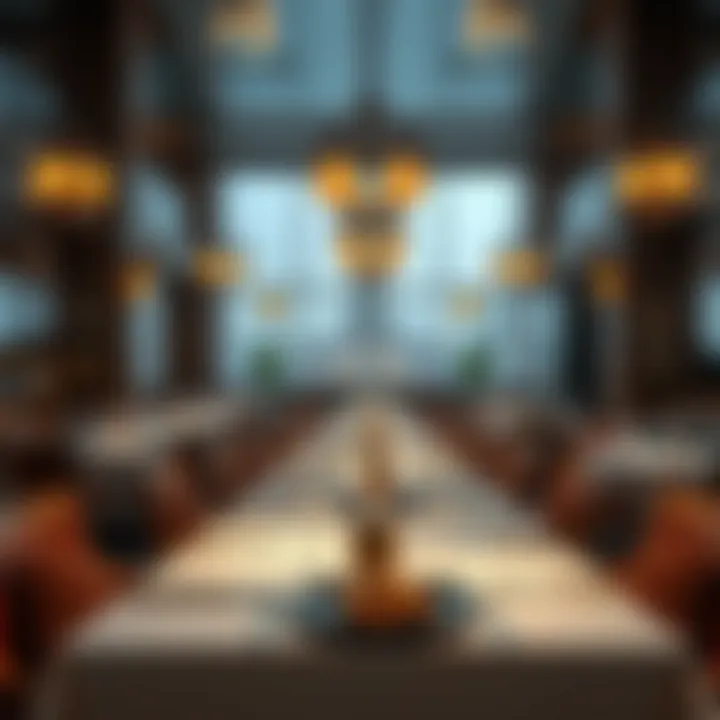
In essence, the growth and establishment of Saudi restaurants in Dubai not only provide an avenue for enjoying flavorful dishes but also play a critical role in cultural exchange. Through the food served and the experiences shared, these dining establishments contribute to a deeper understanding of Saudi Arabian traditions within Dubai’s melting pot of cultures.
Signature Saudi Dishes to Experience
Saudi cuisine holds a prominent place in the culinary tapestry of Dubai, bringing forth an array of rich flavors and traditional cooking methods. It is essential to delve into the hallmark dishes that represent the essence of this culinary culture. These signature dishes not only satiate the palate but also tell a story of heritage, tradition, and communal identity. Understanding and experiencing these dishes provides insight into Saudi Arabian hospitality, making them a pivotal part of any exploration of Saudi dining in Dubai.
Kabsa: The Iconic Rice Dish
Kabsa, often hailed as the national dish, is a rice dish that is central to Saudi Arabian cuisine. Cooked with an assortment of spices, including saffron, cardamom, and cloves, Kabsa is typically made with chicken, lamb, or fish, each version delivering distinct flavors. The rice is usually slow-cooked, absorbing all the intricate spices and juices, resulting in a fragrant and flavor-packed meal.
In Dubai, a visit to a Saudi restaurant without trying Kabsa would be akin to going to Paris and skipping the Eiffel Tower. It is served during celebrations, family gatherings, and during any significant occasion, making it a communal dish meant to bring people together. Some eateries in Dubai, such as Al-Tazaj, offer their unique spins on this traditional favorite, combining authenticity with nuances that cater to local tastes.
Mandi: Tradition Meets Flavor
Mandi is another staple of Saudi cuisine, often regarded as a cousin to Kabsa. The dish is a fusion of richly spiced meat and buttery rice, traditionally cooked in an underground oven called a tandoor. This method of cooking results in tender meat that practically falls off the bone while infusing the rice with smoky flavors. Mandi is often enhanced with nuts and raisins, providing delightful textural contrasts.
Restaurants like Al Mandi in Dubai are known for their Mandi, giving diners an experience that echoes the depth of tradition along with the skillful art of preparation. The atmosphere and craftsmanship behind this dish extend beyond mere sustenance; it beckons diners to bond over shared meals and stories, creating a memorable culinary experience.
Shawarma and Other Street Foods
Shawarma, while not exclusive to Saudi cuisine, has become a beloved fixture in both Saudi Arabia and Dubai. Stacked meats, marinated and roasted on a vertical spit, are shaved thin and wrapped with fresh vegetables and sauces in pita bread. The interactiveness of grabbing a shawarma from a street vendor and the countless variations available make it a favorite for many.
In addition to shawarma, street food offerings like falafel and Arabic sweets bring vibrancy and variety to the dining scene. Food trucks and casual eateries throughout Dubai celebrate these delicious options, often reimagining classic flavors for modern tastes. The remarkable fusion of traditional components with contemporary presentation not only highlights the culinary prowess but also shows the adaptability of Saudi cuisine in a cosmopolitan setting.
Dining Atmosphere and Cultural Decor
The dining atmosphere and cultural decor constitute fundamental elements shaping the experience one encounters at Saudi restaurants in Dubai. These aspects envelop patrons in a sensory journey that goes beyond just the food presented. It offers a unique glimpse into Saudi heritage and tradition, allowing diners to appreciate the deeper connections between cuisine and culture.
Ambience of Saudi Restaurants in Dubai
The ambiance within Saudi restaurants often reflects a blend of traditional and contemporary aesthetics. Upon stepping in, one can expect to be greeted by warm hues, intricate textiles, and wooden furniture that evokes a sense of history. The illumination is typically soft, creating a cozy and inviting space that encourages interaction among diners.
For instance, many establishments adorn their walls with artwork representing local traditions, such as calligraphy or geometric patterns that are prevalent in Saudi culture. This not only beautifies the space but also serves as conversation starters. The subtle background music, often featuring traditional Saudi melodies, contributes to a nurturing environment. The combination of these elements can transform an ordinary meal into a feast for all senses, enhancing the overall dining experience.
Moreover, seating arrangements are often crafted to promote both intimacy and socialization. In many cases, families are encouraged to share large platters of food, aligning with Saudi customs of communal eating. This layout fosters a unique atmosphere where friendships and bonds can be nurtured over a shared love for good food, echoing how meals are traditionally enjoyed back home.
Cultural Artifacts and Their Significance
Cultural artifacts provide a tangible connection to the traditions and practices that define Saudi Arabia. Within the context of restaurants, these items serve as significant representations of the past and present. You may spot items like traditional coffee pots, handmade pottery, and woven rugs adorning the restaurant’s decor.
The presence of such artifacts does more than just decorate a space; they tell stories. For instance, a beautifully crafted dallah (the Arabic coffee pot) is not just an emblem of hospitality but represents centuries-old traditions where coffee serves as a central element in social gatherings. Similarly, intricate plates and serving dishes symbolize the pride in craftsmanship and serve to elevate the authenticity of Saudi culinary presentations.
Additionally, some restaurants might go a step further by featuring spaces dedicated to cultural displays, where patrons can learn about the historical significance of certain dishes or cooking methods in Saudi culture. This kind of immersive experience enriches the dining experience, allowing customers to forge deeper connections not only with the food but also with the culture it represents.
In summation, the combination of thoughtful ambiance and carefully curated cultural artifacts plays a crucial role in shaping one's understanding and appreciation of Saudi cuisine in Dubai. This enriched environment not only showcases traditional fare but also invites diners to celebrate the rich tapestry of Saudi culture, making their culinary journey truly unforgettable.
Influence of Saudi Culture on Dubai's Culinary Scene
The culinary landscape of Dubai is a tapestry woven from many cultures, and Saudi cuisine undeniably stands as a pivotal thread in this intricate design. This influence extends beyond just the availability of dishes; it represents a rich cultural interplay that resonates with both residents and travelers alike. Understanding how Saudi culture shapes the dining experiences in Dubai reveals much about the broader narrative of culinary globalization and exchange between societies.
Cultural Exchange Through Food
Every meal tells a story, and in Dubai, Saudi dining offers what one might call a food narrative rich in tradition and innovation. Food, in this context, serves not merely as sustenance but as a medium through which cultural values are transmitted. In Dubai, the abundance of Saudi restaurants—such as Al-Mandi and Shish Taouk—creates platforms for cultural exchange, where diners can experience the deep-rooted flavors and techniques that define Saudi cuisine.
The dishes served are steeped in history and tradition. For instance, Kabsa, a communal rice dish, is often prepared during gatherings and celebrations, reflecting the importance of family and community in Saudi culture. These traditional practices do not simply fade away in Dubai; they evolve and adapt, incorporating locally sourced ingredients such as saffron and spices found in the UAE. In this manner, the culinary heritage of Saudi Arabia is both preserved and transformed, creating a cultural mosaic that delights the senses.
Moreover, events like food fairs and cultural festivals often showcase Saudi dishes alongside other Middle Eastern cuisines, promoting a greater understanding and appreciation among the diverse population of Dubai. Such activities allow residents from various backgrounds to savor the authenticity of Saudi flavors while also examining their origins, thus deepening the cultural exchange through food.


Impact on Local and International Palates
The ripple effect of Saudi culinary traditions extends into the broader realm of Dubai's gastronomic scene, influencing not just expatriates but locals and tourists alike. Increased awareness and interest in authentic Saudi dishes has led to a renaissance of flavors that appeals to varied taste profiles.
Saudi cuisine’s rich flavors, with its balance of spices and aroma, have encouraged local diners to step beyond their culinary comfort zones. Experimental dishes often feature fusion elements—such as adding Emirati spices to traditional Mandi—allowing chefs to cater to diverse palates.
This culinary fusion exemplifies how the flavors of Saudi Arabia have landed in restaurants across Dubai.
- A growing trend is evident:
- Saudi Shawarma variations are now being served with local sauces, creating a delightful twist.
- Coffee houses feature Arabic coffee blends combined with local delights such as dates and nut-based desserts.
By incorporating Saudi elements into their offerings, Dubai's establishments not only cater to a craving for authenticity but also signal the intermingling of cultures. This moments of encounters foster rich culinary experiences that attract tourists seeking genuine flavors while also allowing locals to celebrate their ancestry through food.
"Food is a universal language, transcending barriers and building communities, one plate at a time."
Prominent Saudi Restaurants to Visit
The vibrant culinary scene in Dubai is a melting pot, hosting a plethora of establishments that not only tantalize taste buds but also embody the cultural richness of their origins. Among these, prominent Saudi restaurants stand out as essential destinations for anyone looking to delve into the sumptuous world of Saudi cuisine. These eateries offer much more than mere meal options; they serve as cultural hubs where tradition and modernity intertwine. By visiting these restaurants, diners can savor authentic flavors while also gaining insights into Saudi hospitality and culinary heritage.
Authentic Dining Experiences
Dining in Saudi establishments in Dubai often transcends the act of eating—it transforms into an experience steeped in cultural significance. The atmosphere plays a crucial role; many Saudi restaurants are designed to replicate the warmth of home, complete with intricate decorative elements that reflect the kingdom’s rich history. Here are some notable features of the dining experience:
- Traditional Seating Arrangements: Expect to find floor seating adorned with plush cushions; this setup encourages kinship and communal eating, central to Saudi dining.
- Cultural Decor: Many restaurants showcase traditional artifacts—such as ornate Arabian coffee pots and beautifully woven textiles—that tell stories of Arabia’s past.
- Family-Style Service: Food is often served in large platters, encouraging sharing and social interaction. This method mirrors how meals are enjoyed in Saudi households, emphasizing the importance of togetherness and community during meals.
Diners might find themselves partaking in rituals associated with food, like serving coffee before and after the meal, a reflection of the gracious hospitality that Saudi culture is known for.
Modern Takes on Traditional Dishes
While authenticity is vital, the culinary landscape in Dubai also embraces innovation. Prominent Saudi restaurants continuously evolve, marrying cherished traditional recipes with modern gastronomic techniques and presentations. Here’s what to look for:
- Creative Twists on Kabsa: This iconic dish, usually prepared with fragrant basmati rice and a mixture of spices, is sometimes infused with contemporary elements like truffle oil or served on unique plates.
- Artful Presentation of Mandi: While traditionally a humble dish, modern interpretations focus on enhancing visual appeal, ensuring that every plate is as captivating to the eye as it is to the palate.
- Fusion Street Foods: Shawarma, a beloved street food staple, can be found with gourmet twists, like a fusion of sauces and additional toppings that elevate the experience.
By blending tradition and modernity, these restaurants invite discerning diners to explore familiar tastes in exciting, new ways. This intersection of culinary practices makes Saudi cuisine in Dubai not only accessible but also intriguing for investors and food enthusiasts alike.
"Food is not just nourishment; it’s a narrative that unfolds over shared plates and stories."
Prominent Saudi restaurants contribute significantly to Dubai’s diverse culinary landscape. They not only celebrate the flavors of Saudi Arabia but also foster cultural dialogue, making them must-visit spots for anyone keen on exploring the nuances of this rich cuisine.
For more on Saudi culinary traditions, consider visiting resources like Britannica or Wikipedia for deeper insights.
Food Festivals and Celebrations in Dubai
Food festivals and culinary celebrations in Dubai serve as vibrant showcases for the city’s diverse gastronomic landscape. For expats, investors, and enthusiasts of food, these events present a unique opportunity to dive into the flavors of various cultures, particularly those of Saudi cuisine. With its rich heritage, Saudi Arabia’s culinary offerings are becoming increasingly prominent within Dubai’s bustling food scene. These festivals not only emphasize the significance of food in cultural identity but also attract food lovers eager to savor authentic dishes that tell a story.
The focus on food festivals allows for cultural exchange, where communities come together with their specialties. It highlights the culinary skills of chefs and home cooks who strive to keep traditions alive while adapting to contemporary tastes. Festivals like the Dubai Food Festival or the Taste of Dubai are platforms where Saudis and other cultural groups can collaboratively celebrate their culinary arts, fostering a sense of community.
Highlighting Saudi Participation
Saudi participation in Dubai’s food festivals is a testament to the deep-rooted ties between the two regions. Saudi chefs and culinary experts often showcase their talents, bringing authentic cuisine to the fore. At these events, attendees can sample dishes like Kabsa and Mandi prepared by seasoned chefs, as well as learn about the stories behind these ingredients.
Events may also feature cooking demonstrations, allowing visitors to engage with Saudi culinary techniques— from the slow-cooked aroma of spiced rice meat dishes to the intricate marination process of Shawarma. Engaging directly with the chefs can foster an appreciation for the skill involved, encouraging locals and expats alike to replicate these traditional dishes in their own kitchens.
Popular Saudi Contributions at Festivals:
- Kabsa: A spiced rice dish accompanied by grilled meat, often the spotlight of Saudi culinary traditions.
- Mandi: Renowned for its unique flavors and preparation style, it’s often highlighted in cooking demonstrations.
- Sweets like Baklava: These sweet delights often bring a traditional touch that appeals universally.

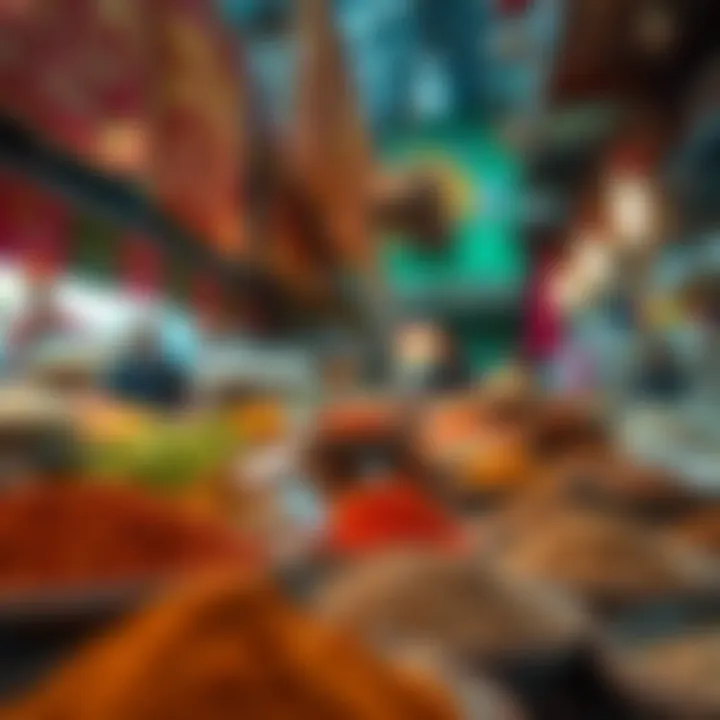
Culinary Competitions Featuring Saudi Flavors
Culinary competitions at food festivals are exciting arenas where chefs can flex their gastronomic muscles. These contests often spotlight Saudi dishes, entering chefs into a friendly rivalry that amplifies the appreciation for Saudi cuisine’s intricacies. Competitors may innovate traditional dishes or create fusion foods that keep the spirit of Saudi culinary excellence alive.
Participants come from various backgrounds, offering perspectives that enrich the competition. With expert judges evaluating based on taste, presentation, and authenticity, chefs are compelled to uphold the highest standards. The resulting dishes not only tantalize taste buds but also educate attendees about the cultural narratives woven into each meal.
Furthermore, judging panels often include culinary experts from Saudi Arabia, adding a layer of legitimacy and insight. The buzz surrounding such competitions garner significant attention, drawing food bloggers, critics, and food enthusiasts eager to witness the best Saudi culinary talents in action.
In sum, food festivals and celebrations in Dubai play a pivotal role in bridging cultures and creating a culinary melting pot. Saudi participation in these events accentuates the vast tapestry of flavors available to residents and visitors. As Dubai continues to evolve as a culinary destination, Saudi cuisine will certainly forge a notable path forward.
The Role of Expatriates in Saudi Cuisine
When discussing the culinary tapestry of Saudi cuisine in a city like Dubai, the role of expatriates often takes center stage. Expats don't just spice up the food scene; they bring a unique blend of flavors and traditions that enhance the experience of dining out. Their influence has become increasingly prominent, especially in a cosmopolitan area where diverse cultures converge.
Community and Cultural Preservation
Expatriates often find themselves in a delicate balance of preserving their heritage while adapting to a new environment. For many, food becomes a conduit for maintaining cultural identity and community ties. Through shared meals, community events, and social gatherings centered around cooking, expatriates help keep the culinary traditions of their home countries alive.
In Dubai, it’s not uncommon to hear the sizzling of Turkish kebabs or the enticing aroma of Indian spices wafting through the air. Each dish tells a story, connecting people to their homeland while inviting locals and fellow expats to partake in these cultural celebrations. Food festivals, for instance, feature dishes prepared by various expatriates, showcasing authenticity while encouraging cultural exchange.
Moreover, some expatriates create community organizations where they organize culinary classes or workshops. These initiatives not only educate newcomers about Saudi cuisine but also offer opportunities for cultural immersion. People learn about dished like Kabsa and Mandi, the nuances of their preparation, and the traditions surrounding them.
"Food is a universal language; by sharing our dishes, we break down barriers and build bridges across cultures."
This phrase captures the essence of why expatriates play an essential role in preserving the culinary heritage of their countries. Each bite of a traditional dish carries the weight of history, memory, and personal stories.
Saudi Chefs and Their Culinary Contributions
The involvement of Saudi expatriate chefs in Dubai's culinary scene has amplified the visibility of authentic dishes. Many of these chefs have trained in renowned culinary institutes but carry rich family traditions in their cooking styles. By opening restaurants that serve traditional dishes like Shawarma and Mandi, these chefs contribute their expertise while staying true to their roots.
Saudi chefs serve not just food; they serve culture and narratives through their menus. Their endeavors don't stop at merely recreating old family recipes; many infuse modern techniques or local ingredients into traditional dishes, offering a refreshing take that simultaneously honors the past.
For potential investors or anyone interested in the market, the surge of Saudi expats establishing dining establishments signals growing demand for authenticity amidst Dubai's diverse culinary scene. This trend can be beneficial for those aiming to tap into the ever-expanding gastronomic landscape of the city. Not only does it showcase Saudi culture, but it also fosters a sense of belonging for expatriates.
As they navigate the challenges of running a business in a foreign land, Saudi chefs often collaborate with local suppliers and farmers, promoting sustainability and supporting the local economy. Their culinary contributions are a testament to the enriching impact of expatriates in making Dubai a melting pot of flavors.
Finale: The Future of Saudi Dining in Dubai
The landscape of Saudi dining in Dubai is poised for an intriguing evolution as both local and global influences meld. At the heart of this transformation lies a vibrant exchange of culinary traditions, which presents opportunities not only for restaurant owners but also for investors and consumers alike. The future seems bright, as diners become more adventurous, seeking out authentic flavors from various cultures, particularly those rooted in Saudi traditions.
As we observe the growth of Saudi dining establishments in Dubai, it’s evident that this culinary genre is more than just a trend; it embodies a deeper appreciation for rich heritage and community. With each plate of Kabsa or Mandi served, the restaurants are not just feeding their patrons but are also sharing a cultural narrative that honors centuries of culinary history. This story is essential for Saudi expatriates who yearn for a taste of home and locals eager to broaden their palate.
Continuing Trends in Saudi Cuisine
Among the continuing trends in Saudi cuisine is the rise of fusion dishes, where traditional recipes meet modern cooking techniques. For instance, chefs are experimenting by infusing familiar Saudi ingredients with influences from around the world. Imagine a Kabsa made with quinoa or a Mandi with South Asian spices. This creative twist ensures that Saudi food remains relevant in a constantly evolving culinary landscape.
Additionally, the push towards organic and sustainable sourcing is gaining traction. Many restaurants are adopting farm-to-table practices, where fresh ingredients from local farmers are prioritized. This not only enhances the flavors but also aligns with the growing consumer demand for transparency in food sourcing. The focus on health and wellness can reshape how Saudi cuisine is presented and perceived in Dubai.
- Fusion Innovations: Chefs blending traditions to create new dining experiences.
- Sustainable Practices: An emphasis on organic and locally sourced ingredients.
Moreover, there is a growing appetite for culinary experiences that transcend dining. Cooking classes, food tours, and interactive dining setups are gaining popularity, allowing patrons to engage with Saudi culture beyond just the food. As culinary tourism flourishes, it opens up avenues for chefs and restaurateurs to innovate and connect with a wider audience.
Culinary Connections in a Global City
In a melting pot like Dubai, the connections between different culinary traditions are increasingly noticeable. Saudi cuisine is no exception, as it nestles comfortably amid an array of global flavors. The appeal for diners lies not only in savoring Saudi dishes but also in the communal experience that food brings. Restaurants often serve as cultural hubs, fostering friendships and collaboration among diverse communities.
The role of social media cannot be overlooked in this regard. Platforms like Instagram and TikTok have become crucial for promoting Saudi cuisine. Pictures of elaborately presented platters and videos of traditional cooking techniques are captivating food enthusiasts, drawing them into the world of Saudi flavors. This visibility opens new doors and promotes cultural dialogue.
"In Dubai, Saudi cuisine is bridging gaps, creating friendships, and celebrating diversity through the simple act of sharing food."
Moreover, as expatriates share their culinary traditions, they invite culinary dialogue and inspire cross-cultural culinary variations. Events and festivals focused on food are becoming common, reflecting not just the culinary art but also embracing different cultures. This interconnected landscape helps global residents diversify their culinary experiences while fostering a spirit of inclusivity.
In summary, the future of Saudi dining in Dubai reflects a broader narrative about cultural appreciation and culinary inclusivity. As the demand for authentic Saudi dishes continues to grow, establishment owners will undoubtedly adapt, ensuring not only survival but vibrancy within this beautiful tapestry of flavors.















